Gartner 2013 数据集成工具魔力象限报告
gartner 魔力象限 入围标准

如何评估 Gartner 魔力象限的入围标准?1. 介绍在科技行业,Gartner 魔力象限是一个广为人知的评估工具,它帮助企业和投资者了解不同市场上技术供应商的表现。
Gartner 魔力象限的入围标准是如何确定的呢?这篇文章将介绍如何评估 Gartner 魔力象限的入围标准,以及深入探讨其中的意义和影响。
2. Gartner 魔力象限的背景Gartner 魔力象限是 Gartner 公司开发的一种市场评估工具,它主要用于对不同技术领域的供应商进行评估和排名。
它基于两个关键维度:对市场的完整理解以及对竞争力的评估。
在魔力象限报告中,供应商被分成四个象限:领导者、挑战者、幻想家和执行者,这有助于用户更好地了解供应商的市场地位和能力。
3. Gartner 魔力象限入围标准的重要性Gartner 魔力象限的入围标准对于企业和投资者非常重要。
它不仅可以帮助企业选择可靠的技术供应商,还可以指导投资者进行投资决策。
Gartner 魔力象限的入围标准需要经过严格的评估和确定,以确保其客观和可靠。
4. 如何评估 Gartner 魔力象限的入围标准评估 Gartner 魔力象限的入围标准需要从多个角度进行综合考量。
评估标准需要具有客观性和公正性,不受任何利益干扰。
评估标准需要考虑技术供应商的市场地位、创新能力、财务状况、客户满意度等多个方面,以全面评估其综合实力。
另外,评估标准还需要及时性和灵活性,能够适应市场变化和技术发展的需求。
5. 个人观点和理解在我看来,评估 Gartner 魔力象限的入围标准需要坚持客观、公正和全面的原则,避免受到外部因素的干扰。
评估标准需要不断更新和调整,以适应快速变化的市场和技术环境。
除了定量数据,还需要结合定性因素进行评估,以全面了解技术供应商的实际情况。
6. 总结评估 Gartner 魔力象限的入围标准是一个复杂而重要的过程。
它需要客观、公正、全面地考量技术供应商的市场地位、创新能力、财务状况等多个方面,以确保评估结果的准确性和可靠性。
SSL VPN
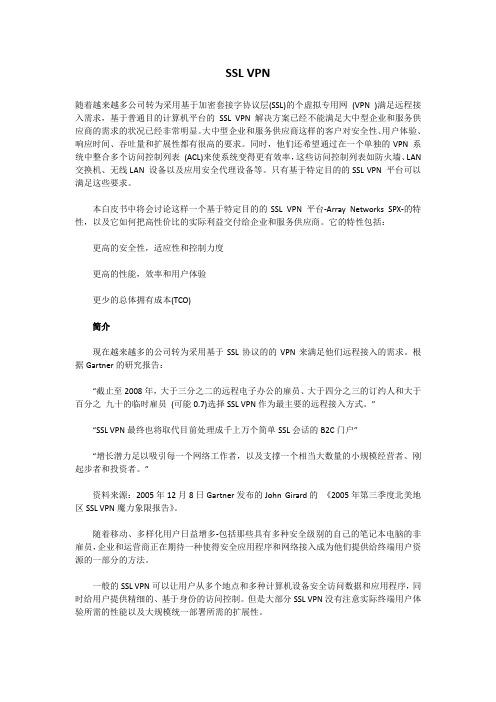
SSL VPN随着越来越多公司转为采用基于加密套接字协议层(SSL)的个虚拟专用网(VPN )满足远程接入需求,基于普通目的计算机平台的SSL VPN 解决方案已经不能满足大中型企业和服务供应商的需求的状况已经非常明显。
大中型企业和服务供应商这样的客户对安全性、用户体验、响应时间、吞吐量和扩展性都有很高的要求。
同时,他们还希望通过在一个单独的VPN 系统中整合多个访问控制列表(ACL)来使系统变得更有效率,这些访问控制列表如防火墙、LAN 交换机、无线LAN 设备以及应用安全代理设备等。
只有基于特定目的的SSL VPN 平台可以满足这些要求。
本白皮书中将会讨论这样一个基于特定目的的SSL VPN 平台-Array Networks SPX-的特性,以及它如何把高性价比的实际利益交付给企业和服务供应商。
它的特性包括:更高的安全性,适应性和控制力度更高的性能,效率和用户体验更少的总体拥有成本(TCO)简介现在越来越多的公司转为采用基于SSL协议的的VPN来满足他们远程接入的需求。
根据Gartner的研究报告:“截止至2008年,大于三分之二的远程电子办公的雇员、大于四分之三的订约人和大于百分之九十的临时雇员(可能0.7)选择SSL VPN作为最主要的远程接入方式。
”“SSL VPN最终也将取代目前处理成千上万个简单SSL会话的B2C门户”“增长潜力足以吸引每一个网络工作者,以及支撑一个相当大数量的小规模经营者、刚起步者和投资者。
”资料来源:2005年12月8日Gartner发布的John Girard的《2005年第三季度北美地区SSL VPN魔力象限报告》。
随着移动、多样化用户日益增多-包括那些具有多种安全级别的自己的笔记本电脑的非雇员,企业和运营商正在期待一种使得安全应用程序和网络接入成为他们提供给终端用户资源的一部分的方法。
一般的SSL VPN可以让用户从多个地点和多种计算机设备安全访问数据和应用程序,同时给用户提供精细的、基于身份的访问控制。
Gartner:2013年移动应用开发平台魔力象限
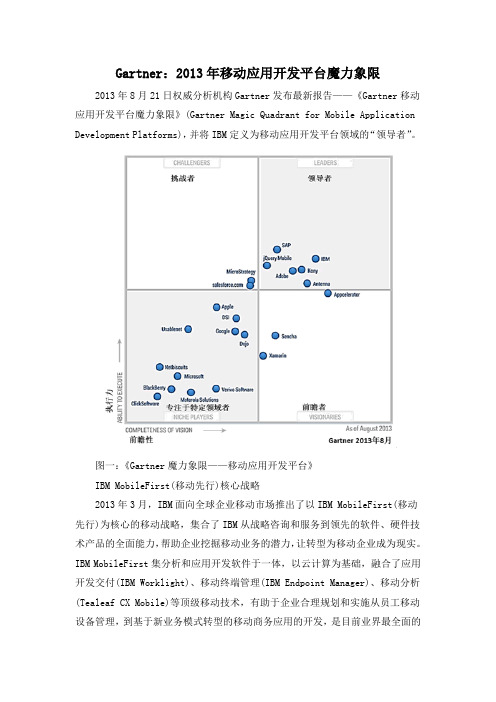
Gartner:2013年移动应用开发平台魔力象限2013年8月21日权威分析机构Gartner发布最新报告——《Gartner移动应用开发平台魔力象限》(Gartner Magic Quadrant for Mobile Application Development Platforms),并将IBM定义为移动应用开发平台领域的“领导者”。
图一:《Gartner魔力象限——移动应用开发平台》IBM MobileFirst(移动先行)核心战略2013年3月,IBM面向全球企业移动市场推出了以IBM MobileFirst(移动先行)为核心的移动战略,集合了IBM从战略咨询和服务到领先的软件、硬件技术产品的全面能力,帮助企业挖掘移动业务的潜力,让转型为移动企业成为现实。
IBM MobileFirst集分析和应用开发软件于一体,以云计算为基础,融合了应用开发交付(IBM Worklight)、移动终端管理(IBM Endpoint Manager)、移动分析(Tealeaf CX Mobile)等顶级移动技术,有助于企业合理规划和实施从员工移动设备管理,到基于新业务模式转型的移动商务应用的开发,是目前业界最全面的企业移动解决方案。
在Gartner的新报告中,IBM凭借Worklight移动应用开发平台所展现出的出色前瞻性和卓越执行力而入选“领导者”象限。
在不到一年的时间内,IBM就从“专注于特定领域者”上升到了“领导者”。
在此之前,IBM MobileFirst的服务和软件能力(包括IBM Worklight)已经在今夏发布的Gartner魔力象限移动领域的相关报告中赢得了好评:包括2013年7月,IBM在《Garner魔力象限:应用安全测试》( Gartner Magic Quadrant for Application Security Testing) 《Gartner应用安全测试魔力象限》,2013年7月,G0*******报告中被评为“领导者”。
Microsoft–Gartner数据库管理系统魔力象限领导者.pdf
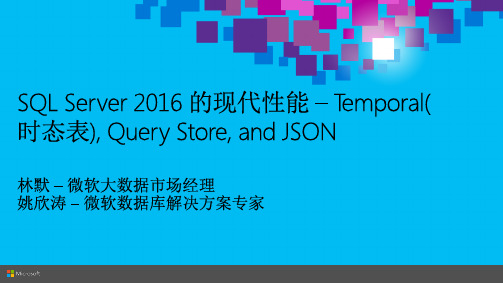
Microsoft – Gartner数据库管理系统魔力象限领导者Microsoft在愿景和执行力两项评比中位列第一.Gartner报告在微软优势描述中特别提到客户对SQL Server的性能,文档帮助,安装运维能力给予微软的高度评价。
报告显示,微软不仅在非结构化数据,混合数据云平台,移动支持和混合事务分析处理(HTAP)方面处于市场领先地位,而且在企业级关键任务的平台上具有竞争优势. { }•INSERT / BULK INSERT •UPDATE •DELETE •MERGE DML •SELECT * FROM temporal Querying•FOR SYSTEM_TIME •AS OF •FROM..TO •BETWEEN..AND •CONTAINED INTemporal Querying •CREATE temporal TABLE PERIOD FOR SYSTEM_TIME… •ALTER regular_table TABLE ADD PERIOD… DDL 新的语法不需改动开发模型* Old versionsInsert / Bulk Insert Update */ Delete *正常查询(当前数据) * 包括历史版本时态表查询 *(time travel, etc.)SELECT *FROM DepartmentFOR SYSTEM_TIMEAS OF '2010.01.01'Azure SQL Database数据库出问题了 网站没响应 无法发现真正原因 性能突然下降 新系统的Bug数据库升级找到并修复regressions问题定位消耗资源最多的查询排除SQL Server 升级的风险深度分析负载的状况Query StoreCheck for Recompile Compile and Optimize Query Fetch Plan from Cache Plan Cache lookupExecute QueryFinish ExecutionQuery ExecutionFound Not foundNot neededRecompileSend text and plan Get forced plan启用 QueryStore (ALTER DB)让 QueryStore 收集书数据搜索有问题的的查询使用 FORCEPLAN 策略安装SQL Server •保持原有兼容级别运行QueryStore(create abaseline)升到SQLServer 2016的兼容级别用force plan来修复regressions问题SQL Server 2016查询优化器的提升和数据库 compatibility level (兼容级别)相一致的[ { "Number":"SO43659", "Date":"2011-05-31T00:00:00" "AccountNumber":"AW29825", "Price":59.99, "Quantity":1 }, { "Number":"SO43661", "Date":"2011-06-01T00:00:00“ "AccountNumber":"AW73565“, "Price":24.99, "Quantity":3 } ] NumberDate Customer Price Quantity SO436592011-05-31T00:00:00 AW29825 59.99 1 SO43661 2011-06-01T00:00:00 AW73565 24.99 3SELECT * FROM myTable FOR JSON AUTOSELECT * FROM OPENJSON (@json)CREATE TABLE SalesOrderRecord(Id int PRIMARY KEY IDENTITY,OrderNumber NVARCHAR(25)NOT NULL,OrderDate DATETIME NOT NULL,JSalesOrderDetails NVARCHAR(4000)CONSTRAINT SalesOrderDetails_IS_JSONCHECK ( ISJSON(JSalesOrderDetails)>0 ),ASCAST(JSON_VALUE(JSalesOrderDetails, ‘$.Order.Qty’) AS int),AS JSON_VALUE('$.Order.Price'),)GOCREATE INDEX idxJsonON SalesOrderRecord(Quantity)INCLUDE (Price);SELECT t.Id, t.OrderNumber, t.OrderDate,JSON_VALUE(t.JSalesOrderDetails,'$.Order.ShipDate') AS ShipDateFROM SalesOrderRecord AS tWHERE ISJSON(t.JSalesOrderDetails)> 0AND t.Price > 1000SELECT t.Id,OrdersArray.Customer,OrdersArray.DateFROM SalesOrderRecord AS tCROSS APPLYOPENJSON (t.JSalestOrderDetails,'$.Orders.OrdersArray') WITH (Number varchar(200)'$.Order.Number',Date datetime'$.Order.Date',Customer varchar(200)'$.AccountNumber',Quantity int'$.Item.Quantity') AS OrdersArray;Azure DocumentDB使用时态表来执行数据审计和基于时间的查询Query Store: 数据库的飞行数据记录器和性能排错工具JSON 沟通关系数据和非关系数据的桥梁谢谢!。
2013年商业智能BI行业分析报告

2013年商业智能行业分析报告2013年12月目录一、商业智能介绍 (3)二、商业智能与大数据 (6)三、全球BI市场,两类小企业脱颖而出 (8)四、中国BI市场仍处于初级阶段 (14)五、投资思路 (16)一、商业智能介绍商业智能(即BI)是一种为企业提供大规模数据联机处理、数据挖掘、数据分析,以及报表展现等服务,以实现对特定的商业目标或企业整体绩效提供定量化决策支持的综合解决方案。
商业智能的关键是从许多来自不同的企业运作系统的数据中提取出有用的数据并进行清理,以保证数据的正确性,然后经过抽取(Extraction)、转换(Transformation)和装载(Load),即ETL 过程,合并到一个企业级的数据仓库里,从而得到企业数据的一个全局视图,在此基础上利用合适的查询和分析工具、数据挖掘工具、OLAP 工具等对其进行分析和处理(这时信息变为辅助决策的知识),最后将知识呈现给管理者,为管理者的决策过程提供支持。
商业智能的实现涉及到软件、硬件、咨询服务及应用,其基本体系包括信息获取、信息管理、商业应用三个部分。
在传统的BI 解决方案中更多的将商业应用部分作为BI 的主体,近年来随着BI 企业级应用的增多,以及海量数据处理的需求,将ETL、数据仓库、数据挖掘、OLAP、分析模型、信息展现整合为一起综合的BI 应用逐渐普及。
资料来源:《商业智能介绍》商业智能为企业各个层次的人员提供不同的信息:战略决策层将通过建立战略企业管理模式的商务智能系统来实时了解企业对战略目标的执行程度;中、高层管理人员通过建立运营智能系统来随时了解企业运行情况;企业分析研究人员则可通过商务智能分析工具对企业现状进行分析,向高层领导提供分析结果,支持决策。
华为服务器虚拟化软件产品彩页

开放兼容、敏捷可靠、性能领先华为FusionSphere云操作系统HUAWEI TECHNOLOGIES CO., LTD.企业云计算IT基础设施建设面临的挑战信息技术正以前所未有的方式改变着我们的生活,为人们的工作和生活带来极大的便利。
然而企业IT应用已远远落后于个人,CIO们需要运用新的技术进行IT变革,实现更加敏捷的应用,创造更多商业价值。
云计算已经成为各行业公认的IT变革方向。
但在云计算部署过程中,CIO们会面临各种挑战。
首先,在一个典型的云基础设施中,既包含了物理资源与虚拟资源,又普遍存在着不同厂商和制式的软硬件,如何能在业务云化的同时避免对现有业务造成影响,又如何创新以寻求差异化价值;其次,业务增长压力大,但投资预算有限,如何以最优的成本结构获得领先同行的性能,满足业务的增长需求;最后,兼容第三方的开放平台仍然是所有答案的基础,既要面向未来,又要兼顾过去,原有IT投资必须得到保护。
毫无疑问,企业在建设云计算平台时遇到的情况必然是非常复杂的,但对于用户来讲,能够满足自己的需求、适合自己的业务特点的云计算架构就是最好的,成熟的云计算平台应是一个开放的、异构的、支持各种不同业务特征的支撑平台。
最具竞争力的云操作系统FusionSphereFusionSphere是华为公司面向多行业客户推出的云操作系统产品,整个系统专门为云设计和优化,提供强大的虚拟化功能和资源池管理、丰富的云基础服务组件和工具、开放的API接口等,可以帮助客户水平整合数据中心物理和虚拟资源,垂直优化业务平台,让企业的云计算建设和使用更加简捷。
2014年7月,在Gartner发布的《X86服务器虚拟化魔力象限》报告中,华为成为当年唯一新上榜成员,并被评价为“一款在新兴市场中大有潜力的产品”。
华为FusionSphere深度融合了OpenStack架构,构筑了更完整的软件定义数据中心能力(含软件定义存储、软件定义网络等)和更强的管理自动化能力,并能支撑电信业务云化商用能力(NFV,网络功能虚拟化)。
魔力象限之应用性能监控

魔力象限之应用性能监控日期:2010年2月18日您需要了解的情况本文修订于2010年2月25日。
如欲了解更多信息,请参见上的更正页面。
应用性能监控(APM)现在需要实现五大不同功能维度的协调决策,其中包括最终用户体验监控(end-user experience monitoring)、用户自定义事务处理剖析(user-defined transaction profiling)、应用组件发现和建模(application component discovery and modeling)、应用组件深入监控(application component deep-dive monitoring),以及应用性能数据库功能(application performance management database capabilities)。
通过魔力象限,企业可指导厂商进行决策,并评估厂商是否能提供不同功能维度的支持。
基本上,厂商产品会在这五大功能维度中有各自不会的表现,所以企业通常需要从不同产品系列综合选取,从而获得满足自身要求的最佳组合。
魔力象限图1. 采用魔力象限实现应用性能监控数据来源:Gartner(2010年2月)作者:Will Cappelli企业需求推动IT运营管理进一步以应用为中心,同时应用管理的难度也在增大。
厂商如何解决应用性能监控问题,将会对其是否在整个市场上占据重要地位产生重大影响。
注释Gartner魔力象限评估工作需要花费大量时间,厂商可能会在我们完成分析报告后才发表更新产品。
鉴于此,我们会在不同厂商的评价中明确指出分析的产品版本。
我们鼓励您与厂商展开讨论,共同探索当前产品版本能不能解决我们所分析版本中的局限性问题。
厂商的增减我们根据市场变化更改魔力象限和MarketScopes中的厂商名单标准。
因此,不同时期魔力象限或MarketScopes的厂商名单可能不同。
如果某家厂商某年出现在魔力象限或MarketScope名单里而次年又从名单消失,并非表示我们对厂商的评价有所变化,这可能反映了市场在发生变化以及由此导致的选择标准不同,也可能说明厂商的业务重点发生了变化。
应用交付市场两极分化-Gartner ADC魔力象限解读

应用交付市场两极分化-Gartner ADC魔力象限解读导语Gartner最近发布了2013版应用交付市场魔力象限分析报告,对比2012年10月的报告和今年最新的报告图的整体格局来看,领导者象限依旧是F5,Citrix,Radware三强。
值得注意的是,Citrix更加逼近于F5,而Radware从去年处于领导象限的边缘,今年无论在Vision,还是在Execute执行表现上,Radware都有明显的提升,这相当大一部分原因得益于对Strangeloop的收购。
在挑战者象限,A10 Networks成为2007年以来唯一入选此象限的厂商。
Niche Player 小角色象限,深信服继去年后再一次入选Gartner魔力象限。
F5F5在营收数额与创新成果方面仍然堪称市场上的领导者。
其以应用程序生命周期为核心的创新成果围绕开放API展开,例如iApps、iRules以及iCall等,同时也给平台性能带来提升。
不过这套系统的复杂程度也超出了某些F5渠道合作伙伴及客户的承受能力。
在以与应用程序及虚拟化环境相集成的全部ADC需求(特别是客户最迫切渴望的功能)方面,F5的表现最为出色。
优势●F5的发展视野广泛而且全面,对于AD、部署以及管理方面的需求也具备业界领先的掌控能力。
●F5丰富的内部知识储备以及应用程序环境交付与定制方面的出色表现使其成为复杂环境下最卓越的解决选项。
●F5拥有一套功能齐备的平台,其中包含借由可编程框架实现的高度灵活可编程接口。
在这套接口当中,iRules负责数据规划、iApps负责以应用程序为中心的配置工作、iControl负责管理API与集成事务,iCall则负责控制脚本化。
●F5继续通过执行其云战略以实现云环境下的Big-IP ADC服务部署,例如通过Big-IP云为管理平台(惠普、IBM、微软以及VMware)提供集成所必需的北向API。
而DevOps工具(Opscode、Puppet Labs)则负责对Big-IP ADC层及应用程序实例进行变更。
2020年国产数据库专题报告
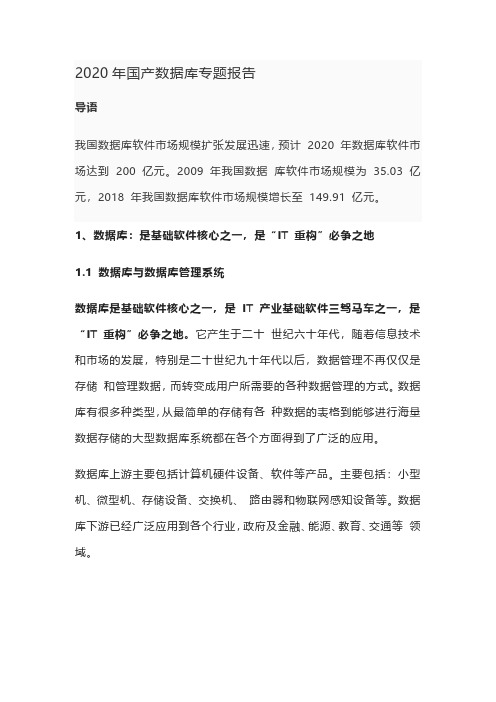
2020年国产数据库专题报告导语我国数据库软件市场规模扩张发展迅速,预计2020 年数据库软件市场达到200 亿元。
2009 年我国数据库软件市场规模为35.03 亿元,2018 年我国数据库软件市场规模增长至149.91 亿元。
1、数据库:是基础软件核心之一,是“IT 重构”必争之地1.1 数据库与数据库管理系统数据库是基础软件核心之一,是IT 产业基础软件三驾马车之一,是“IT 重构”必争之地。
它产生于二十世纪六十年代,随着信息技术和市场的发展,特别是二十世纪九十年代以后,数据管理不再仅仅是存储和管理数据,而转变成用户所需要的各种数据管理的方式。
数据库有很多种类型,从最简单的存储有各种数据的表格到能够进行海量数据存储的大型数据库系统都在各个方面得到了广泛的应用。
数据库上游主要包括计算机硬件设备、软件等产品。
主要包括:小型机、微型机、存储设备、交换机、路由器和物联网感知设备等。
数据库下游已经广泛应用到各个行业,政府及金融、能源、教育、交通等领域。
数据库可分为两大类,分别为关系型数据库和非关系型数据库。
关系型数据库(Rational Database),是指采用了关系模型来组织数据的数据库,其以行和列的形式存储数据。
该模式便于用户理解,关系型数据库这一系列的行和列被称为表,一组表组成了数据库。
用户通过查询来检索数据库中的数据,而查询是一个用于限定数据库中某些区域的执行代码。
关系模型可以简单理解为二维表格模型,而一个关系型数据库就是由二维表及其之间的关系组成的一个数据组织。
NoSQL,泛指非关系型的数据库。
随着互联网web2.0 网站的兴起,传统的关系数据库在处理web2.0 网站,特别是超大规模和高并发的SNS 类型的web2.0 纯动态网站已经显得力不从心,出现了很多难以克服的问题,而非关系型的数据库则由于其本身的特点得到了非常迅速的发展。
NoSQL 数据库的产生就是为了解决大规模数据集合多重数据种类带来的挑战,尤其是大数据应用难题。
主流BI产品分析报告

啦吧吧啦吧吧啦吧吧[日期]目录现状与发展趋势概要概念BI是融合了数据仓库、数据挖掘、联机分析处理等技术系统。
为企业管理层或领导对企业发展的决策提供支持。
其核心就是通过数据提取(挖掘)、整理、分析,最终通过分析结果制定有关策略、规划,帮助企业了解新的趋势、抓住新的市场机会、发现潜在的威胁,达到资源的合理配置,节约成本提高效益。
商业智能可以为企业提供外部和内部两方面的信息分析。
外部信息包括竞争者、供应商、原材料、需求、顾客购买模式等信息,内部信息包括产品和服务的成本、质量,进入市场的时间,全员劳动生产率等等。
主要软件在由数据仓库、查询、报告、OLAP、分析模型、数据挖掘这些不同的功能构成的BI软件里,查询、报告和OLAP工具占据了绝对主流地位,为65%。
而最能体现商业智能价值的分析模型和数据挖掘工具目前还只有少数的几家专门做商业智能软件的厂商,如Business Objects、Cognos和SAS这样的专门做统计分析软件的厂商能够提供。
中国市场里BI厂商的竞争态势主要体现在以下三个层面:第一类公司是那些提供数据库软件或统计软件的跨国大公司,凭借着先进的技术实力和雄厚的资金支持,将产品延伸到BI领域,并将其BI产品打包在其数据库或统计软件中推广,轻而易举地抢占了高端市场。
这类公司包括NCR、Microsoft、CA、Oracle、Sybase、IBM、SAS等。
第二类公司是专门做BI的厂商,主要有三家:Business Objects、Brio和Cognos。
由于是BI的专业生产商,因此在国际BI市场上占据着重要位置。
第三类是国内的BI厂商及行业的ISV,如用友、金蝶、博科等企业。
这些企业一直在开发一些联机分析数据类软件,凭借着其原有财务软件的客户群,市场潜力也不可低估。
但是作为BI产品,其所服务的仍然是低端市场。
BI内各个部分主流软件(全球商业分析软件供应商收益及市场份额)传统型BI:(通常指企业内部大而全的统一报表或分析平台,以老牌IT厂商为主)IBM的cognos,Oracle的OBIEE,SAP的BO等等,均包含丰富的功能模块,比较适合于打造一体化的大而全的统一平台。
超融合架构有了自己的Gartner 魔力象限
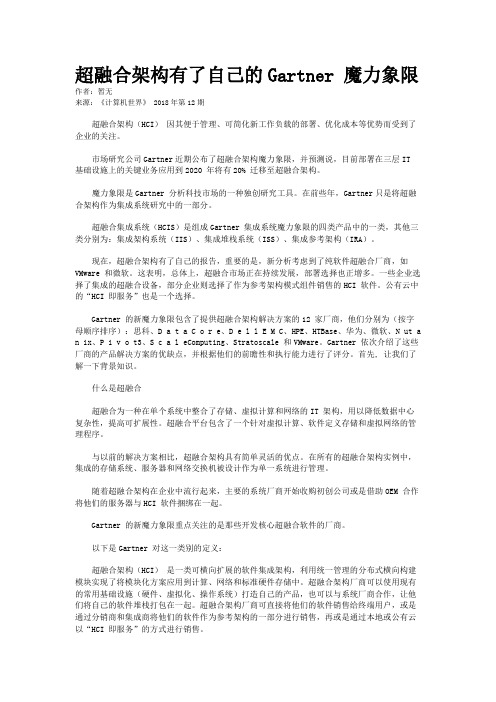
超融合架构有了自己的Gartner 魔力象限作者:暂无来源:《计算机世界》 2018年第12期超融合架构(HCI)因其便于管理、可简化新工作负载的部署、优化成本等优势而受到了企业的关注。
市场研究公司Gartner近期公布了超融合架构魔力象限,并预测说,目前部署在三层IT基础设施上的关键业务应用到2020 年将有20% 迁移至超融合架构。
魔力象限是Gartner 分析科技市场的一种独创研究工具。
在前些年,Gartner只是将超融合架构作为集成系统研究中的一部分。
超融合集成系统(HCIS)是组成Gartner 集成系统魔力象限的四类产品中的一类,其他三类分别为:集成架构系统(IIS)、集成堆栈系统(ISS)、集成参考架构(IRA)。
现在,超融合架构有了自己的报告,重要的是,新分析考虑到了纯软件超融合厂商,如VMware 和微软。
这表明,总体上,超融合市场正在持续发展,部署选择也正增多。
一些企业选择了集成的超融合设备,部分企业则选择了作为参考架构模式组件销售的HCI 软件。
公有云中的“HCI 即服务”也是一个选择。
Gartner 的新魔力象限包含了提供超融合架构解决方案的12 家厂商,他们分别为(按字母顺序排序):思科、D a t a C o r e、D e l l E M C、HPE、HTBase、华为、微软、N ut a n ix、P i v o t3、S c a l eComputing、Stratoscale 和VMware。
Gartner 依次介绍了这些厂商的产品解决方案的优缺点,并根据他们的前瞻性和执行能力进行了评分。
首先, 让我们了解一下背景知识。
什么是超融合超融合为一种在单个系统中整合了存储、虚拟计算和网络的IT 架构,用以降低数据中心复杂性,提高可扩展性。
超融合平台包含了一个针对虚拟计算、软件定义存储和虚拟网络的管理程序。
与以前的解决方案相比,超融合架构具有简单灵活的优点。
在所有的超融合架构实例中,集成的存储系统、服务器和网络交换机被设计作为单一系统进行管理。
商业智能十大品牌简介

IBM在商业智能领域拥有领先的技术和深厚的专业知识,被广泛认为是行业的领导者。
IBM的商业智能产品和服务已被全球众多企业和组织采用,涵盖金融、零售、制造、医疗等多个行业。
IBM在商业智能领域的创新和专业知识使其成为该领域的领导者,并对整个行业产生了深远的影响。
02
CHAPTER
品牌二:Oracle
Oracle成立于1989年,总部位于美国加州,是全球领先的企业软件和数据库公司。其业务涉及云计算、大数据、人工智能等领域,为全球各行各业的客户提供全面的IT解决方案。
Oracle商业智能软件是该公司的重要产品之一,它提供了强大的数据分析、报表生成、数据挖掘等功能,帮助企业更好地了解市场和客户需求,提升决策效率。此外,Oracle还提供了一系列的数据仓库和数据安全产品,以及各种企业级应用软件,如ERP、CRM、人力资源管理系统等。
总部地点:瑞典
QlikView、Qlik Sense、Qlik Cloud、Qlik Narrative等
产品
数据可视化、数据挖掘、数据分析、数据报告等
服务
在全球范围内拥有大量的客户和合作伙伴,对商业智能领域的发展具有重要影响力和推动作用
全球商业智能市场中的领导者之一,连续多年在Gartner魔力象限报告中被评为领导者
Power BI已经成为许多企业和组织的数据分析平台,为决策者提供了快速、准确的数据支持。
Power BI在云计算、大数据、人工智能等领域都有广泛的应用,对整个商业智能行业产生了深远的影响。
THANKS
感谢您的观看。
CHAPTER
品牌八:Domo
成立时间:2010年
连续7年领跑IaaS魔力象限,AWS究竟靠的是什么?
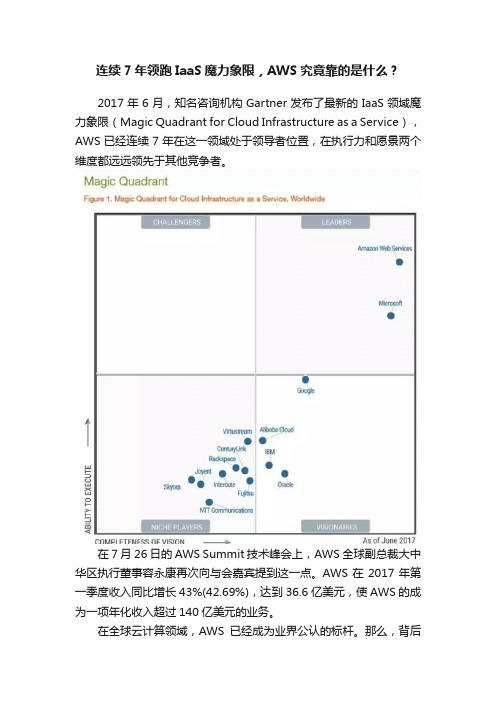
连续7年领跑IaaS魔力象限,AWS究竟靠的是什么?2017年6月,知名咨询机构Gartner发布了最新的IaaS领域魔力象限(Magic Quadrant for Cloud Infrastructure as a Service),AWS已经连续7年在这一领域处于领导者位置,在执行力和愿景两个维度都远远领先于其他竞争者。
在7月26日的AWS Summit技术峰会上,AWS全球副总裁大中华区执行董事容永康再次向与会嘉宾提到这一点。
AWS在2017年第一季度收入同比增长43%(42.69%),达到36.6亿美元,使AWS的成为一项年化收入超过140亿美元的业务。
在全球云计算领域,AWS已经成为业界公认的标杆。
那么,背后AWS究竟凭借什么优势做到的呢?一般人只看到了亚马逊的成功,没有看到它多年的积累和试错在亚马逊AWS首席云计算企业顾问张侠博士看来,AWS商业成功和备受欢迎主要原因有三个:•AWS在功能的深度和广度,以及持续创新方面,一直处在领先的地位;•众多的用户和合作伙伴一起组成生态系统。
当客户在某方面有需求的时候,在AWS的生态系统里能找到一群成功的案例,直接可以借鉴;•AWS有丰富的运维经验,带来相对稳定、可靠的云的服务。
抛开官方的问答,笔者认为超前的洞察和战略布局是AWS成功不可复制的重要因素。
国内云计算行业大致从2012年进入快速发展通道,而早在2006年,亚马逊就已经开始了AWS的尝试和积累。
AWS全球副总裁大中华区执行董事容永康一语道破了亚马逊持续创新、持续领先的实质:“很多时候当亚马逊提出一个新的概念的时候,大家还在说这个东西行不行的时候,其实我们已经积累了很多内部的测试的经验。
当它达到一定成熟的经验的时候,我们还会把相关的资源开放出来,给我们的一些客户去用。
”百变的企业需求,百宝箱一样的AWS在亚马逊首席技术执行官WernerVogels博士的现场演讲中,最令他激动的就是AWS能像百宝箱一样应对全球那么多企业各种各样的云需求。
基于自然语言处理和深度学习的nl2sql技术及其在bi增强分析中的应用
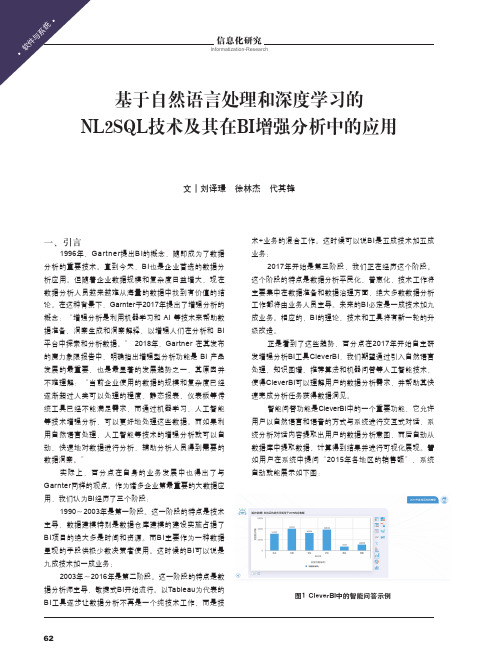
文|刘译璟 徐林杰 代其锋基于自然语言处理和深度学习的NL2SQL技术及其在BI增强分析中的应用一、引言1996年,Gartner 提出BI 的概念,随即成为了数据分析的重要技术。
直到今天,BI 也是企业首选的数据分析应用。
但随着企业数据规模和复杂度日益增大,现在数据分析人员越来越难从海量的数据中找到有价值的结论。
在这种背景下,Garnter 于2017年提出了增强分析的概念:“增强分析是利用机器学习和 AI 等技术来帮助数据准备、洞察生成和洞察解释,以增强人们在分析和 BI 平台中探索和分析数据。
” 2018年,Gartner 在其发布的魔力象限报告中,明确指出增强型分析功能是 BI 产品发展的最重要、也是最显著的发展趋势之一,其原因并不难理解:“当前企业使用的数据的规模和复杂度已经逐渐超过人类可以处理的程度,静态报表、仪表板等传统工具已经不能满足需求,而通过机器学习、人工智能等技术增强分析,可以更好地处理这些数据。
而如果利用自然语言处理、人工智能等技术的增强分析就可以自动、快速地对数据进行分析,辅助分析人员得到需要的数据洞察。
”实际上,百分点在自身的业务发展中也得出了与Garnter 同样的观点。
作为诸多企业第最重要的大数据应用,我们认为BI 经历了三个阶段:1990~2003年是第一阶段。
这一阶段的特点是技术主导,数据建模特别是数据仓库建模的建设实施占据了BI 项目的绝大多是时间和资源。
而BI 主要作为一种数据呈现的手段供极少数决策者使用。
这时候的BI 可以说是九成技术加一成业务;2003年~2016年是第二阶段。
这一阶段的特点是数据分析师主导,敏捷式BI 开始流行。
以Tableau 为代表的BI 工具逐步让数据分析不再是一个纯技术工作,而是技术+业务的混合工作。
这时候可以说BI 是五成技术加五成业务;2017年开始是第三阶段,我们正在经历这个阶段。
这个阶段的特点是数据分析平民化、普惠化,技术工作将主要集中在数据准备和数据治理方面,绝大多数数据分析工作都将由业务人员主导。
Blue Coat居Gartner广域网优化控制器魔力象限领导者象限

全套件 以及专 门针对嵌入式装置软件的 自动化测试系统,来进
行 各项 动态测 试 。
2 O 2 0 2 1
9: 7 嬲圈瓯圈
w 、 w nSC O 1 0 C n
指 导和 规 范利 用信 息 系 统处理 个 人信 息 的活动 ,从 而推 动 我 国
ห้องสมุดไป่ตู้
可能减少对网络的影响。这可以支持企业的视 频计划,而不会
增加 网络 带宽 成本 ,也不 会 影响企 业 关键 业 务应 用 的性 能 视 频 交 付 是 M C5解 决 方 案 全 面 集 成 的功 能,支 持 Aoe F s AH db lh a、
应用。
锵勿 联网 “ 十二五”发展规划 要求建立信息安全预警和管理机制 工业和 信息 化部 日前公 布《 联 网“ 二五 ” 物 十 发展 规划》 出 , 指
将 在今 后五年 建 立第 三方参 与 的信息 安全 预警和 管理 机 制。
风河 与 C v r y就嵌 入式软 件开 发安 全性展 开合 作 o ei t
解 决 方 案 则 可 自动 扫描 程 式 原 始码 找 出安全 漏 洞 与 品 质瑕 疵 ,
权 。随 着大 来卡 的加入 ,金雅 拓现 在 已为 所有 国际支 付 组织 供 应 芯片卡 解决 方案 ,提供 完整 的 安全 支 付应 用组合 。 大来 国际 ( ir Cu Ie aia)隶属 于发 现金 融服务 公 D e l n r t n1 n s tn o b
司,是一个全球性支付 F络,遍及 15个国家。金雅拓 目前为 1 8
大 来 卡全 球发 卡机 构 的 芯片 卡迁 移 项 目提供 智 能银 行卡 及相 关 的发卡 服 务 。大来 卡持 卡 人 在进 行金 融 交 易 时将享 受 到更加 安 全 的服 务 ,并且 在 国际旅行 时获 得 更加 方便 的支 付选择 。 Bu a 居 G rnr leCot ate 广域 网优 化控 制器 魔力象 限领 导者象 限
工业互联网最强报告:一文细数IIoT市场趋势、行业玩家、平台现状,未来发展……
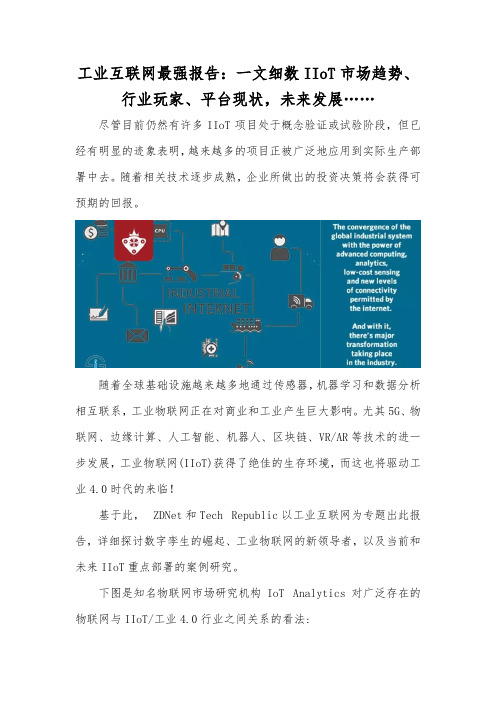
工业互联网最强报告:一文细数IIoT市场趋势、行业玩家、平台现状,未来发展……尽管目前仍然有许多IIoT项目处于概念验证或试验阶段,但已经有明显的迹象表明,越来越多的项目正被广泛地应用到实际生产部署中去。
随着相关技术逐步成熟,企业所做出的投资决策将会获得可预期的回报。
随着全球基础设施越来越多地通过传感器,机器学习和数据分析相互联系,工业物联网正在对商业和工业产生巨大影响。
尤其5G、物联网、边缘计算、人工智能、机器人、区块链、VR/AR等技术的进一步发展,工业物联网(IIoT)获得了绝佳的生存环境,而这也将驱动工业4.0时代的来临!基于此,ZDNet和Tech Republic以工业互联网为专题出此报告,详细探讨数字孪生的崛起、工业物联网的新领导者,以及当前和未来IIoT重点部署的案例研究。
下图是知名物联网市场研究机构IoT Analytics对广泛存在的物联网与IIoT/工业4.0行业之间关系的看法:在万物互联时代,由于广泛存在的传感器、数据网络和分析能力,供应链将拥有端到端的透明度。
在所有其他条件(例如贸易壁垒)相同的情况下,零部件和原材料将被及时送达高度自动化的工厂,并可对在此生产的产品进行从生产直到最终回收利用的全生命周期追踪管理。
类似地,“智能农场”也将把新兴的IIoT相关技术整合到基于机器人、大数据和人工智能分析的高分辨率作物生产系统中。
因此,部署IIoT系统的企业将会显著提高运营效率、更加环保,并获得大量优质的数据作为未来其他计划的基础。
尽管如此,上述所讲的都只是相关技术理论,那么在具体的实际应用情况如何呢?谁在部署IIOT解决方案?PTC调研结果PTC是领先的IIoT软件平台提供商,其在2018年2月发布了一份调查研究,结果显示,美洲是采用IIoT最多的地区(45%),其次是欧洲、中东、非洲地区(33%)和亚太地区(22%)。
采用IIoT解决方案的主要行业是工业产品领域(25%),其次是电子高科技产品领域(23%)和汽车产品领域(13%):报告称:“这些行业之所以可以引领物联网潮流,是由于它们拥有复杂的制造和运营流程以及高资产价值的设备,因此可以从物联网解决方案和数字化转型中获得很高收益,而这又将进一步推动企业建设更可持续、更有弹性和更高效的流程。
统一通信研究报告--魔力象限
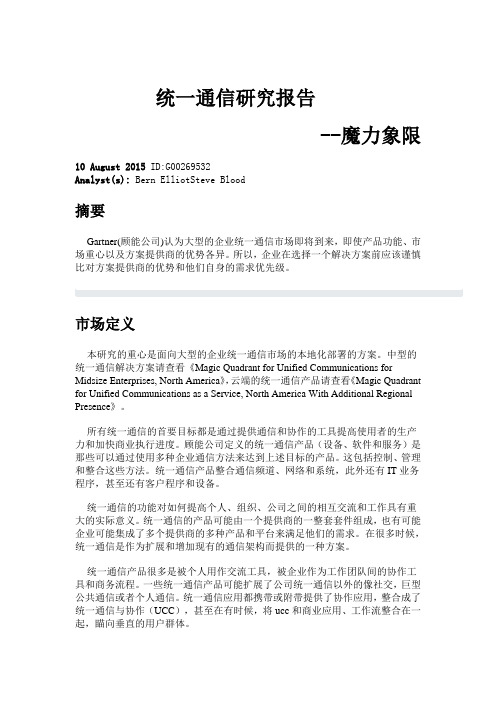
统一通信研究报告--魔力象限10 August 2015 ID:G0*******Analyst(s): Bern ElliotSteve Blood摘要Gartner(顾能公司)认为大型的企业统一通信市场即将到来,即使产品功能、市场重心以及方案提供商的优势各异。
所以,企业在选择一个解决方案前应该谨慎比对方案提供商的优势和他们自身的需求优先级。
市场定义本研究的重心是面向大型的企业统一通信市场的本地化部署的方案。
中型的统一通信解决方案请查看《Magic Quadrant for Unified Communications for Midsize Enterprises, North America》,云端的统一通信产品请查看《Magic Quadrant for Unified Communications as a Service, North America With Additional Regional Presence》。
所有统一通信的首要目标都是通过提供通信和协作的工具提高使用者的生产力和加快商业执行进度。
顾能公司定义的统一通信产品(设备、软件和服务)是那些可以通过使用多种企业通信方法来达到上述目标的产品。
这包括控制、管理和整合这些方法。
统一通信产品整合通信频道、网络和系统,此外还有IT业务程序,甚至还有客户程序和设备。
统一通信的功能对如何提高个人、组织、公司之间的相互交流和工作具有重大的实际意义。
统一通信的产品可能由一个提供商的一整套套件组成,也有可能企业可能集成了多个提供商的多种产品和平台来满足他们的需求。
在很多时候,统一通信是作为扩展和增加现有的通信架构而提供的一种方案。
统一通信产品很多是被个人用作交流工具,被企业作为工作团队间的协作工具和商务流程。
一些统一通信产品可能扩展了公司统一通信以外的像社交,巨型公共通信或者个人通信。
统一通信应用都携带或附带提供了协作应用,整合成了统一通信与协作(UCC),甚至在有时候,将ucc和商业应用、工作流整合在一起,瞄向垂直的用户群体。
Gartner魔力象限
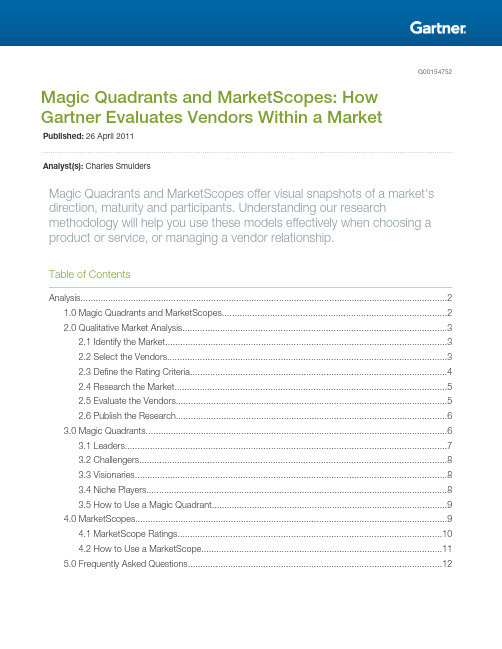
G0******* Magic Quadrants and MarketScopes: How Gartner Evaluates Vendors Within a MarketPublished: 26 April 2011Analyst(s): Charles SmuldersMagic Quadrants and MarketScopes offer visual snapshots of a market's direction, maturity and participants. Understanding our research methodology will help you use these models effectively when choosing a product or service, or managing a vendor relationship.Table of Contents Analysis (2)1.0 Magic Quadrants and MarketScopes (2)2.0 Qualitative Market Analysis (3)2.1 Identify the Market (3)2.2 Select the Vendors (3)2.3 Define the Rating Criteria (4)2.4 Research the Market (5)2.5 Evaluate the Vendors (5)2.6 Publish the Research (6)3.0 Magic Quadrants (6)3.1 Leaders (7)3.2 Challengers (8)3.3 Visionaries (8)3.4 Niche Players (8)3.5 How to Use a Magic Quadrant (9)4.0 MarketScopes (9)4.1 MarketScope Ratings (10)4.2 How to Use a MarketScope (11)5.0 Frequently Asked Questions (12)List of TablesTable 1. MarketScope Rating Framework (11)List of FiguresFigure 1. Market Life Cycle (3)Figure 2. The Magic Quadrant (7)Figure 3. The MarketScope (10)Analysis1.0 Magic Quadrants and MarketScopesAssessing a market and its participants is a daunting task. Vendor differentiation caused by differing sizes, levels of complexity and strategies can inhibit comparisons of vendor offerings, and themarket's overall direction is often murky. Gartner's Magic Quadrants and MarketScopes solve these problems by offering snapshots of markets and their participants, enabling you to map vendorstrengths against your current and future needs.Markets vary in many ways, but all follow a predictable life cycle with these phases: embryonic,emerging, high-growth, consolidating, maturity and declining. A market's current phase helpsdetermine which model we use to assess it:■Magic Quadrants depict markets in the middle phases of their life cycle by using a two-dimensional matrix that evaluates vendors based on their completeness of vision and ability toexecute. The Magic Quadrant has 15 weighted criteria that plot vendors based on their relativestrengths in the market. This model is well suited for high-growth and consolidating marketswhere market and vendor differentiations are distinct.■MarketScopes rate vendors based on criteria that focus on the important aspects of an emerging or mature market. In emerging markets, vendors and products are less well known ortested in the market, and it would be difficult to analyze all criteria typically used in a MagicQuadrant. In mature markets, vendors and products are typically well known, and demand forrelative comparison shifts to a focus on differentiating criteria. By focusing on a limited set ofcriteria for these markets, MarketScopes will help you understand the dynamics of the market,as well as the strengths of its vendors, even when the market is not well suited for MagicQuadrant analysis.For example, we may analyze an emerging market with a MarketScope and use a Magic Quadrantwhen the market enters its high-growth phase. We then may return to a MarketScope as the market matures (see Figure 1).Page 2 of 13Gartner, Inc. | G0*******Figure 1. Market Life CycleMarket SizePhase 13245Source: Gartner (April 2011)2.0 Qualitative Market AnalysisTo evaluate vendors for Magic Quadrants and MarketScopes, Gartner uses a comprehensiveprocess that defines the boundaries of the market, research focus and the steps taken to form the analysis.2.1 Identify the MarketTo be considered for a Magic Quadrant or MarketScope, a market must be distinct and viable. It is selected for analysis based on the impact of emerging trends and users' need to understand changing market dynamics. We focus on markets in which our insights can assist clients with planning, investment decision making and the ongoing support of vendor relationships.2.2 Select the VendorsA Magic Quadrant or MarketScope is not intended to be an exhaustive analysis of every vendor in a market, but rather a focused analysis. Inclusion criteria consist of market share, revenue, number of clients, types of products or services, target market or other defining characteristics that help narrow the scope of the research to those vendors that we consider to be the most important or best suited to our clients' needs.Gartner, Inc. | G0*******Page 3 of 132.3 Define the Rating CriteriaMagic Quadrants use standard criteria in two categories: completeness of vision and ability toexecute. MarketScopes may use up to seven of these criteria to focus on factors that differentiate a particular market. We then adapt the inclusion criteria to a market by prioritizing and weighting them based on a high, low or standard scale of importance. In some cases, a criterion may have a "norating" weight because it has low relevance for the market.2.3.1 Completeness of Vision■Market Understanding: The ability of a vendor to understand buyers' needs and translate these needs into products and services. A vendor that shows the highest degree of visionlistens and understands buyers' wants and needs, which it can shape or enhance with itsvision.■Marketing Strategy: A clear, differentiated set of messages consistently communicated throughout the organization and publicized through the Web site, advertising, customerprograms and positioning statements.■Sales Strategy: A strategy for selling products that uses the appropriate network of direct and indirect sales, marketing, service and communication affiliates to extend the scope and depth ofa vendor's market reach, skills, expertise, technologies, services and customer base.■Offering (Product) Strategy: A vendor's approach to product development and delivery that emphasizes differentiation, functions, methodology and feature set in relation to current andfuture requirements.■Business Model: The validity and logic of a vendor's underlying business proposition.■Vertical/Industry Strategy: A vendor's strategy to direct resources, skills and offerings to meet the needs of market segments, including vertical industries.■Innovation: Marshaling of resources, expertise or capital for competitive advantage, investment, consolidation or defense against acquisition.■Geographic Strategy: A vendor's strategy to direct resources, skills and offerings to meet the needs of regions outside of the vendor's "home" or native area, directly or through partners,channels and subsidiaries, as appropriate for that region and market.2.3.2 Ability to Execute■Product/Service: Core goods and services offered by the vendor that compete in and serve the market. This category includes product and service capabilities, quality, feature sets andskills, offered natively or through original equipment manufacturers, as defined in the marketdefinition and detailed in subcriteria.■Overall Viability: Includes an assessment of the vendor's overall financial health, the financial and practical success of the relevant business unit, and the likelihood of that business unit tocontinue to invest in and offer the product within the vendor's product portfolio.Page 4 of 13Gartner, Inc. | G0*******■Sales Execution/Pricing: The vendor's capabilities in pre-sales activities and the structure that supports them. This criterion includes deal management, pricing and negotiation, pre-salessupport and the overall effectiveness of the sales channel.■Market Responsiveness and Track Record: Ability to respond, change direction, be flexible and achieve competitive success as opportunities develop, competitors act, customer needsevolve and market dynamics change. This criterion also considers the vendor's history ofresponsiveness.■Marketing Execution: The clarity, quality, creativity and efficacy of programs designed to deliver the vendor's message to influence the market, promote its brand and business, increaseawareness of its products and establish a positive identification with the product, brand orvendor with buyers. This "mind share" can be driven by a combination of publicity, promotions,thought leadership, word of mouth and sales activities.■Customer Experience: Relationships, products, and services and programs that enable clients to succeed with the products evaluated. This criterion includes the ways customers receivetechnical support or account support. It can also include ancillary tools, customer supportprograms (and their quality), availability of user groups and service-level agreements.■Operations: The vendor's ability to meet its goals and commitments. Factors include the quality of the organizational structure, such as skills, experiences, programs, systems and othervehicles, that enable the vendor to operate effectively and efficiently.2.4 Research the MarketResearch activities include, but are not limited to:■Vendor briefings■Surveys■Vendor-provided references■Industry contacts■Client interviews■Public sources, such as U.S. Securities and Exchange Commission filings, articles, speeches and published papers■Input from Gartner analysts2.5 Evaluate the VendorsTeams of analysts collaborate to evaluate and score each vendor using the weighted criteria. Theresulting scores are used to generate a Magic Quadrant or MarketScope.Gartner, Inc. | G0*******Page 5 of 132.6 Publish the ResearchThe Magic Quadrant or MarketScope is published as a research document that explains the vendor positions and ratings, as well as new developments in the market, and thus provides a context inwhich to use the models. During this step, the research undergoes rigorous internal peer review and validation, followed by a factual review by the vendors included on the Magic Quadrant orMarketScope.3.0 Magic QuadrantsThe Magic Quadrant figure (see Figure 2) is based on two axes:■Ability to Execute: Summarizes factors such as the vendor's financial viability, market responsiveness, product development, sales channels and customer base.■Completeness of Vision: Reflects the vendor's innovation, whether the vendor drives or follows the market, and if the vendor's view of how the market will develop matches Gartner'sperspective.Page 6 of 13Gartner, Inc. | G0*******Figure 2. The Magic QuadrantAbility toExecuteviability,services,features)Completeness of Vision(in technology, viability, services, features)on VisionariesNiche Players Source: Gartner (April 2011)The vendors positioned in the four quadrants — Leaders, Challengers, Visionaries and Niche Players — share certain characteristics.3.1 LeadersLeaders provide mature offerings that meet market demand, as well as demonstrate the vision necessary to sustain their market position as requirements evolve. The hallmark of leaders is that they focus and invest in their offerings to the point that they lead the market and can affect its Gartner, Inc. | G0*******Page 7 of 13overall direction. As a result, leaders can become the vendors to watch as you try to understandhow new offerings might evolve.Leaders typically possess a large, satisfied customer base (relative to the size of the market) andenjoy high visibility within the market. Their size and financial strength enable them to remain viable in a challenging economy.Leaders typically respond to a wide market audience by supporting broad market requirements.However, they may fail to meet the specific needs of vertical markets or other more-specializedsegments.3.2 ChallengersChallengers have a strong ability to execute but may not have a plan that will maintain a strongvalue proposition for new customers. Larger vendors in mature markets may often be positioned as challengers because they choose to minimize risk or avoid disrupting their customers or their ownactivities.Although challengers typically have significant size and financial resources, they may lack a strongvision, innovation or overall understanding of market needs. In some cases, challengers may offerproducts nearing the end of their lives that dominate a large but shrinking segment.Challengers can become leaders if their vision develops. Large companies may fluctuate betweenthe Challengers and Leaders quadrants as their product cycles and market needs shift.3.3 VisionariesVisionaries align with Gartner's view of how a market will evolve, but they have less-provencapabilities to deliver against that vision. In early markets, this status is normal. In more-maturemarkets, it may reflect a competitive strategy for a smaller vendor — such as selling an innovationahead of mainstream demand — or a larger vendor trying to break out of a rut or differentiate.For vendors and customers, visionaries fall in the higher-risk/higher-reward category. They oftenintroduce new technology, services or business models, and they may need to build financialstrength, service and support, and sales and distribution channels. Whether visionaries becomechallengers or leaders may depend on if companies accept the new technology or if the vendorscan develop partnerships that complement their strengths. Visionaries sometimes are attractiveacquisition targets for leaders or challengers.3.4 Niche PlayersNiche players do well in a segment of a market, or they have a limited ability to innovate oroutperform other vendors. This may be because they focus on a functionality or geographic region,or they are new entrants to the market. Alternatively, they may be struggling to remain relevant in amarket that is moving away from them. Niche players may have reasonably broad functionality butwith limited implementation and support capabilities, and relatively limited customer bases. Theyhave not yet established a strong vision for their offerings.Page 8 of 13Gartner, Inc. | G0*******Assessing niche players is more challenging than assessing vendors in other quadrants becausesome niche players could make progress, while others do not execute well and may not have thevision to keep pace with broader market demands.A niche player may be a perfect fit for your requirements. However, if it goes against the direction ofthe market — even if you like what it offers — then it may be a risky choice because its long-termviability will be threatened.3.5 How to Use a Magic QuadrantYour needs and circumstances should determine how you use the Magic Quadrant, not the otherway around. To evaluate vendors in the Leaders quadrant only and ignore those in other quadrantsis risky and thus discouraged. For example, a vendor in the Niche Players quadrant could offerfunctions that are ideally suited to your needs. Similarly, a leader may not offer functions that meetyour requirements — for example, its offerings may cost more than competitors', or it may notsupport your region or industry. Use a Magic Quadrant to narrow your list of choices, but don't base your decision only on the model. Talk to the Gartner analyst who created the research for moredetails and insight.Vendor positioning in Magic Quadrants illustrates useful information about vendors. For example, ifyou want to make a strategic investment in a technology, then a vendor's viability will be critical.Therefore, weight a vendor's ability to execute more heavily than its completeness of vision, andevaluate challengers before visionaries. Conversely, if you can gain a competitive advantage byinvesting in an emerging technology, then evaluate visionaries before challengers.The overall positioning of vendors in a Magic Quadrant offers a high-level view of the market. In ahighly mature market, a preponderance of vendors may cluster in the Leaders quadrant becausemost vendors will tend to offer a complete set of products and services, with little differentiation. By contrast, in an emerging market, most vendors will cluster in the Niche Players quadrant, and mostofferings will be incomplete yet distinctive.4.0 MarketScopesMarketScopes provide an overall market rating that indicates the strength and potential for themarket in general. This is particularly important in emerging markets, when hype is high and it isdifficult to assess the long-term viability or evolution of offerings. In mature markets, MarketScopes provide insight about the ongoing value of products and services.In addition to the overall market rating, MarketScopes provide ratings for selected vendors basedon market-critical criteria (see Figure 3).Gartner, Inc. | G0*******Page 9 of 13Figure 3. The MarketScopeSource: Gartner (April 2011)4.1 MarketScope RatingsMarketScope ratings and evaluations are limited to a select set of criteria identified in the researchand are not meant to be exhaustive vendor evaluations. The ratings follow Gartner's standard rating format (see Table 1).Page 10 of 13Gartner, Inc. | G0*******Table 1. MarketScope Rating FrameworkSource: Gartner (April 2011)4.2 How to Use a MarketScopeUse a MarketScope to understand — at a high level — the strength and potential of a market and to review vendors in the space. A MarketScope can provide a solid definition of a market, illustrateimportant trends and dynamics that will affect overall market strength, and identify critical criteriathat distinguish vendors in the market.Consider how the criteria used to build the MarketScope map to your priorities. (Remember that aMarketScope uses fewer criteria than a Magic Quadrant.) To illustrate market differentiation, wemay have excluded criteria that are critical to you. For example, in an emerging market, aMarketScope may focus on innovation and market strategy, while your priorities may be financialviability and product functions. In a mature market, a MarketScope might focus on customerexperience and track record, while you need to consider pricing and architectural alignment.Gartner, Inc. | G0*******Page 11 of 13Keep in mind that the list of vendors is representative, not exhaustive. Excluding a vendor from theresearch does not imply that it is not viable or competitive.5.0 Frequently Asked QuestionsCan Magic Quadrants and MarketScopes be used as vendor selection tools? Magic Quadrants and MarketScopes analyze a market and can help you to focus your search on important criteria.However, they will not provide the details needed during the vendor selection process to align yourrequirements to a vendor.Why aren't all vendors from a market included in a Magic Quadrant or MarketScope? In mostcases, it is not possible to cover every vendor in a market — there are too many, or some areirrelevant based on the criteria. Therefore, we focus our research in a way that will provide thegreatest value to Gartner clients. Sales contracts, vendor requests and client engagements do notinitiate or drive inclusion in Magic Quadrant or MarketScope research.What does it mean if a vendor isn't included in a Magic Quadrant or MarketScope? It meansthat they did not meet the inclusion criteria defined for that Magic Quadrant or MarketScope. It does not imply that the vendor is not viable or competitive. It might indicate that the vendor has a slightly different strategy or functional match, or that it addresses a different target market. We publish theinclusion criteria with the Magic Quadrant or MarketScope to help you understand why a vendormight not have been included.Is a market always analyzed the same way? No. As a market matures, it changes and so doesthe analysis. Year to year, the inclusion criteria, weightings and our opinion about what it takes tomaintain market strength may change.Is there a calendar for when Magic Quadrants and MarketScopes will be published? Acalendar of planned Magic Quadrant and MarketScope research is posted on .How often are Magic Quadrants and MarketScopes updated? Magic Quadrants andMarketScopes are updated at least annually and may be updated sooner to respond to marketchanges.How can I compare current Magic Quadrants to previous versions? Previous versions areavailable online as archived files. When performing direct comparisons, understand that the marketdefinition and criteria may have changed, thus affecting vendors' positions or ratings.This is part of two sets of related research. See the following for an overview:■Enterprise Architecture Research Index: Enterprise Technology Architecture■IT Challenges for Enterprises in China, 2012Page 12 of 13Gartner, Inc. | G0*******Regional HeadquartersCorporate Headquarters56 Top Gallant RoadStamford, CT 06902-7700USA+1 203 964 0096Japan Headquarters Gartner Japan Ltd.Atago Green Hills MORI Tower 5F 2-5-1 Atago, Minato-ku Tokyo 105-6205JAPAN+ 81 3 6430 1800European Headquarters Tamesis The Glanty Egham Surrey, TW20 9AW UNITED KINGDOM +44 1784 431611Latin America HeadquartersGartner do BrazilAv. das Nações Unidas, 125519° andar—World Trade Center04578-903—São Paulo SPBRAZIL+55 11 3443 1509Asia/Pacific HeadquartersGartner Australasia Pty. Ltd.Level 9, 141 Walker StreetNorth SydneyNew South Wales 2060AUSTRALIA+61 2 9459 4600© 2011 Gartner, Inc. and/or its affiliates. All rights reserved. Gartner is a registered trademark of Gartner, Inc. or its affiliates. Thispublication may not be reproduced or distributed in any form without Gartner’s prior written permission. The information contained in this publication has been obtained from sources believed to be reliable. Gartner disclaims all warranties as to the accuracy, completeness or adequacy of such information and shall have no liability for errors, omissions or inadequacies in such information. This publicationconsists of the opinions of Gartner’s research organization and should not be construed as statements of fact. The opinions expressed herein are subject to change without notice. Although Gartner research may include a discussion of related legal issues, Gartner does not provide legal advice or services and its research should not be construed or used as such. Gartner is a public company, and its shareholders may include firms and funds that have financial interests in entities covered in Gartner research. Gartner’s Board ofDirectors may include senior managers of these firms or funds. Gartner research is produced independently by its research organization without input or influence from these firms, funds or their managers. For further information on the independence and integrity of Gartner research, see “Guiding Principles on Independence and Objectivity” on its website, /technology/about/ombudsman/omb_guide2.jsp.Gartner, Inc. | G0*******Page 13 of 13。
- 1、下载文档前请自行甄别文档内容的完整性,平台不提供额外的编辑、内容补充、找答案等附加服务。
- 2、"仅部分预览"的文档,不可在线预览部分如存在完整性等问题,可反馈申请退款(可完整预览的文档不适用该条件!)。
- 3、如文档侵犯您的权益,请联系客服反馈,我们会尽快为您处理(人工客服工作时间:9:00-18:30)。
数据集成工具
魔力象限
Gartner 根据“执行能力”和“前瞻性”将Informatica 定位为领导者Informatica 连续七年在Gartner 发布的数据集成
工具魔力象限中位居领导者象限。
Informatica 副
总裁兼数据集成和数据质量总经理Todd
Goldman 表示:“凭借全球首款嵌入式虚拟数据
机Vibe 等创新解决方案,Informatica 始终在数
据集成市场中独占鳌头。
”我们相信,Gartner 对
Informatica 领导者地位的认可进一步证明了
Informatica 始终秉承的对客户的承诺,即通过领
先的产品和解决方案,帮助客户加快实现业务目
标的步伐,并释放其数据潜能。
Gartner 发布的2013 年数据集成工具魔力象限
报告将领导者定义为“将专用工具集成到一种产品
(该产品支持一系列数据交付样式)的领头羊”。
供应商们不但在应用较为传统的数据集成模式方
面有很强的能力,此外,他们还支持新的模式,
可以提供在SOA 环境中启用数据服务的功能。
领导者能够在市场中才智共享,并随时获得能够
娴熟地运用其工具的资源。
通过在产品中提供新
功能并定义那些引入数据集成工具可带来重要价
值的新型业务问题,这些供应商在很大程度上决
定着市场发展趋势。
在领导者的客户当中,跨多
个项目和多个类型的实用案例进行部署的例子很普遍。
”
Informatica 成熟的数据集成平台可随时从任何来源、任何技术将支离破碎的、不可预知的原始数据转换成统一的、高品质的、可操作的信息。
我们由Vibe 虚拟数据机驱动的平台能保证以最有效力和效率的方式完成所承担的IT 项目,从而为企业实现其战略业务目标提供强力支持。
具体来说,Informatica 是通过以下方式向企业提供这一价值:•与传统的手工编码相比,将从设计到部署的数据集成开发速度提高五倍
•基于成熟的技术提供可扩展的、真正集成的解决方案,引领最佳实践,提供世界一流的服务•对数据集成技术的投资有未来保障,使您可以利用技术更新,而无需学习新的技能
了解更多–立即下载Gartner 完整的数据集成工具魔力象限报告(英文)。
此图由Gartner, Inc. 在研究报告中发布,应在整个报告的上下文中进行评估。
点击此处下载Gartner 报告。
Gartner 不对其研究出版物中所述的任何供应商、产品或服务进行宣传,也不建议技术用户只选择那些具有最高评级的供应商。
Gartner 的研究出版物仅代表Gartner 研究机构的观点,不应理解为对事实的陈述。
Gartner 对该项研究不承担任何明示或暗示的担保,包括适销性或针对特定用途适
用性的任何担保。
